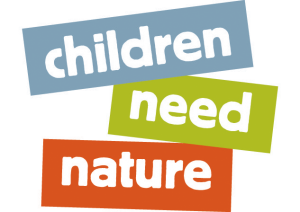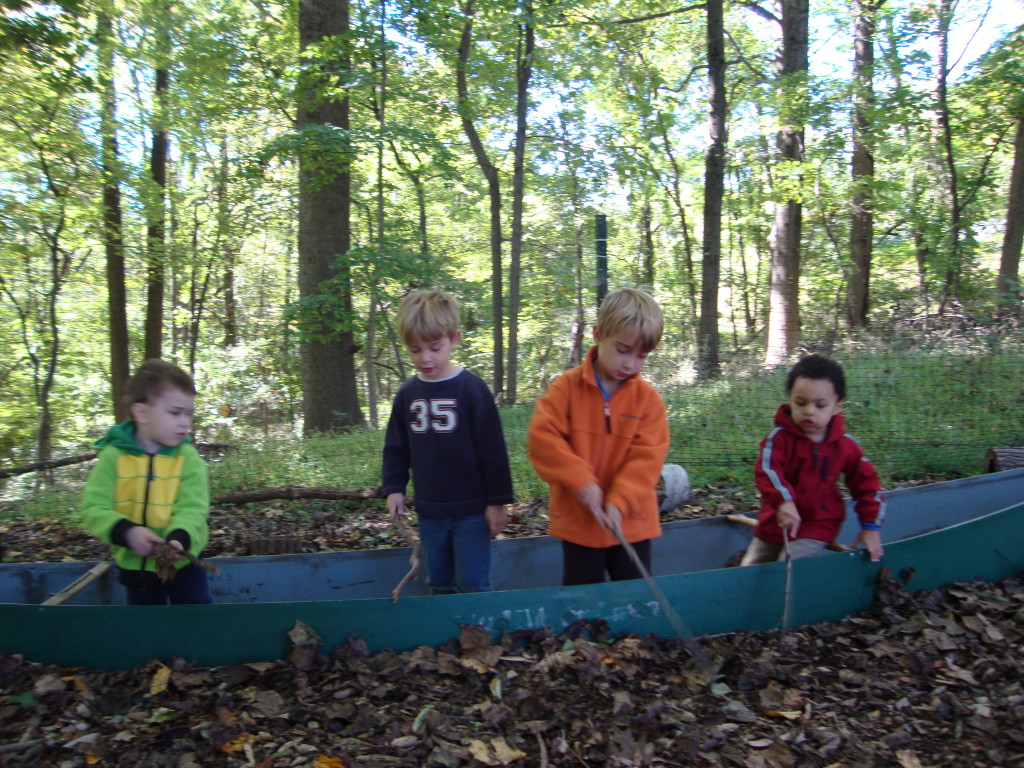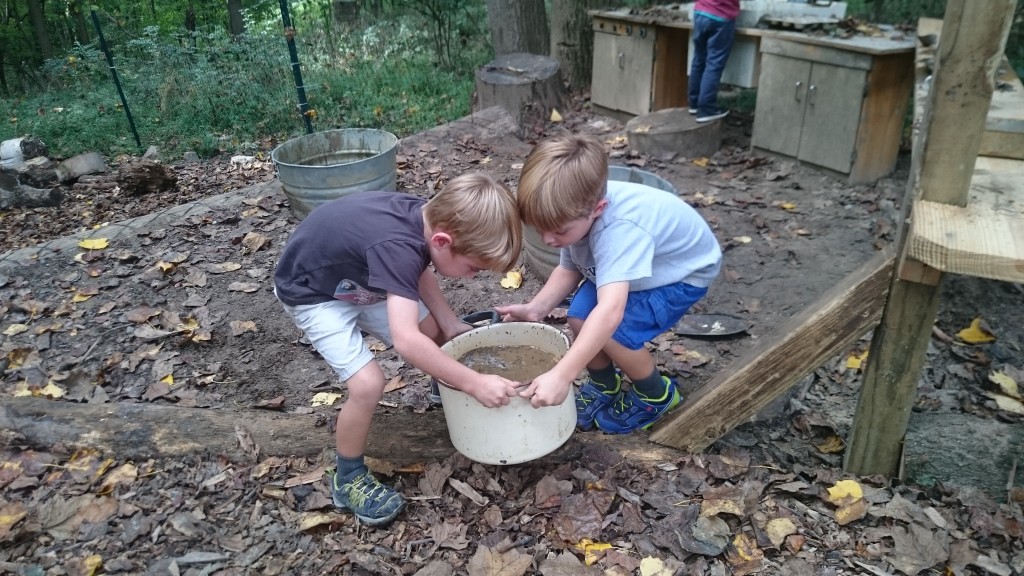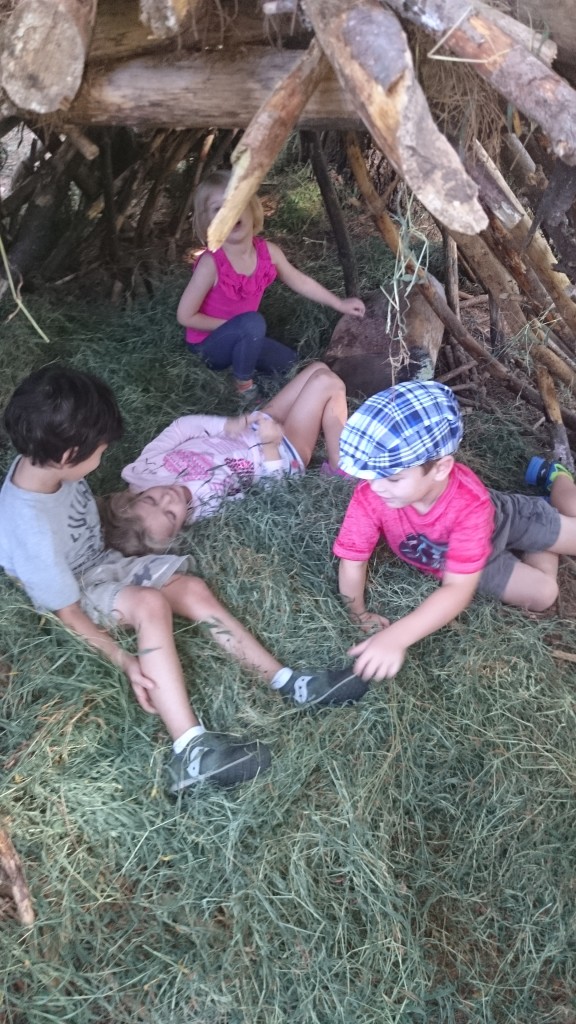 By Rachel Baltuch, Nature Preschool Teacher
By Rachel Baltuch, Nature Preschool Teacher
Children Need Nature is a monthly blog column from our nature preschool program. Read more posts here.
While researching the effects of unstructured play time in nature for young children, I discovered that the benefits are vast and encompass most aspects of children’s development. Play time in nature tends to affect children’s cognitive development, which includes intellectual learning, problem solving skills, and creative inquiry, and can lead to increased concentration, greater attention capacities and higher academic performance.[1] These children also demonstrate “more advanced motor fitness, including coordination, balance and agility, and they are sick less often.[2]
Additionally, the benefits of free play time in nature include reduced stress and symptom relief for some children with Attention Deficit Disorder and Attention Deficit Hyperactivity Disorder.[3] Lastly, unstructured free time in nature can improve children’s social skills, ranging from increasing children’s positive feeling towards one another, decreasing the amount of bullying and violence between children, increasing children’s imagination and creativity, and increasing their communication and language skills.[4]
At this point, I decided to focus my research on how unstructured free play in nature can lead to benefits in children’s social skills. The following is only a sampling of the research I found. At the basis of this research comes the assertion that “dramatic or symbolic play contribute to a range of developmental virtues including communication, cooperation, interpersonal problem solving, creativity, personal responsibility and imagination.”[5] Along this same line of thinking, Strife and Downey assert that “creative play encourages language development and social and collaborative skills”.[6] Keeping this central thought in mind, it makes sense that the more creative and imaginatively based a child’s play, the more he will learn to develop these social skills. Several studies have proven that children’s unstructured free play in nature is simply more creative and imaginative, as well as diverse.[7]
While playing one day in the Schuylkill Center’s Tall Trees Playscape with two Nature Preschoolers, I encountered this premise first hand. Entirely of their own accord, the boy and girl established an intricate play scenario revolving around sailing in a boat. Over the course of half an hour, the children pretended that their oars went overboard, there was a shark attack, a giant squid showed up, they had to pass through a waterfall, make it to an island, and then travel all the way to China and Egypt! I was merely along for the ride on their imaginative adventure.
One of the reasons that play in nature can be so imaginative is the fact that there are more loose parts that can be used as props during play, as opposed to when children play in built environments.[8] The materials in nature can be manipulated and used to build and create, so that children can fully engage in and with them, as opposed to classic playground equipment, which do not have the same allowances.[9]
Another benefit of natural spaces for playing is that nature can truly provide more physical space than a classroom can. Malone and Tranter argue that “even in play environments with considerable space, paucity of equipment and materials limits children’s play options and leads to increased levels of boredom and aggression and lack of social, physical and cognitive development.[10] Having more space and more materials to choose gives children a more interesting play environment, one in which they might not need to pick on each other because there are more important play agendas for them.
One more important aspect of unstructured free play in nature is the fact that adult supervision can be a little less hands-on, to allow for children to learn how to work out their own problems with each other. Malone and Tranter assert that “play enables social and emotional development through activities where children must play with others, share and cooperate, respect other views, express their ideas, feelings and needs without the constant mediation of an adult” (Malone and Tranter, 2003, Section III). I once observed a five year old girl voluntarily teach a three year old girl how to climb up on a large stump and jump off to the ground, with no assistance from a teacher. Both of the girls felt accomplished after achieving this goal. Indeed, this lack of constant adult supervision can also give young children the space they need to establish creative and constructive play with each other in a real way. (Bixler, Floyd, and Hammit, 2002) When children are forced to work out their problems on their own and they have been taught the tools needed to do so, they are more likely to internalize these ideas and communicate with each other in a kind and cooperative manner.
Additionally, another study has found that children have more positive relationships with each other when they play in natural environments, and that these environments can actually encourage the development of children’s social skills.[11] White and Stoecklin agree with this statement, and they also contend that playing in natural spaces can increase the chances for children to participate in active and creative problem solving, individually and with each other.[12] It is clear that there is a greater potential for learning team building skills and problem solving skills when all of the children are comfortable not only participating, but also using their own talents to assist the group in a task. Of course, we must not forget “the role of teachers and the school community in developing a shared philosophy and culture that values and supports children’s relationship with the environment”.[13]
By researching the hypothesis that more unstructured free play in nature for children would likely improve their social skills, I wanted to prove scientifically what I already knew by my observations. I have worked in both traditional preschool settings, where children play on playground equipment for a small portion of their day, and I have worked at a Nature Preschool, where a majority of the child’s day is spent hiking nature trails and playing in an unstructured natural environment. It is extremely obvious to me that while both locations offer the children communities of safety and kindness, the children at the Nature Preschool are better equipped to resolve their own conflicts or resolve them easier with the help of a teacher. They play longer and more creatively in nature, working together constantly.
I have seen a group of six children, between the age range of 3 – 5 and including both genders, play an intricate game of house for over a half an hour in Pine Grove, an area that offers many forts and sticks among which to play. Their game continued without any fights, issues, or teacher intervention until it ended because it was time to leave the forest area. Each child contributed their own ideas, adding onto each other’s directives. If a peer wanted to join their game, the group readily included that child in their play. The children were actively engaged and thinking creatively the entire time. They would even make up their own problems to solve, such as a child who announced “oh no! We are out of food! What should we do?”
These are only a few examples of the myriad I have observed over the past year of my working at the Nature Preschool. While of course there are still children who have conflicts with each other, it tends to be easier to coach them through the process of conflict resolution. Learning these skills at such a young age will most likely benefit these children throughout their entire lives. More importantly, perhaps, we are beginning to scientifically prove what humans have instinctively known forever: children need to be in nature.
 About the Author
About the Author
In 2010, Rachel graduated from the University of Maryland, Phi Beta Kappa, with a B.A. in Judaic Studies and a minor in Linguistics and is currently working towards her Master’s in Early Childhood Education from Chestnut Hill College. In March of 2014, Rachel became an Integrated Sustainability Apprentice at Pearlstone, a Jewish retreat center and farm in Reisterstown, Maryland, where she worked on the organic farm and was trained as an experiential educator. On her return to the Philly area, she taught farm and environmental education at Ramah Day Camp in Elkins Park. Rachel is very happy to have found a preschool that shares all of her values for engaging and educating young children, along with a teaching team of dedicated and caring individuals. She looks forward to sharing in the love and wonder of nature with all of the students.
References
Bixler, R. D., Floyd, M. F., Hammitt, W.E. (2002, Nov.). Environmental Socialization:
Quantitative Tests of the Childhood Play Hypothesis. Environment and Behavior, 34(6), 795-818. doi: 10.1 1771001 391602237248
Faber Taylor, A., & Kuo, F. E. (2006). Is contact with nature important for healthy child
development? State of the evidence. In C. Spencer and M. Blades (Eds.), Children and their Environments. Retrieved from http://faculty.une.edu/cas/szeeman/GK-12/articles/FaberTaylorKuo2006.pdf
Natural Learning Initiative. (2012, January). Benefits of Connecting Children with Nature: Why
Naturalize Outdoor Learning Environments. Retrieved from https://naturalearning.org/sites/default/files/Benefits%20of%20Connecting%20Children%20with%20Nature_InfoSheet.pdf
Malone, K. & Tranter, P. (2003). Children’s Environmental Learning and the Use, Design and
Management of Schoolgrounds. Children, Youth, and Environments, 13(2). Retrieved from http://www.colorado.edu/journals/cye/13_2/Malone_Tranter/ChildrensEnvLearning.htm
Strife, S., & Downey, L. (2009, March). Childhood Development and Access to Nature: A New
Direction for Environmental Inequality Research. Organ Environ., 22(1), 99-122. doi: 10.1177/1086026609333340
White, R. (2004). Young Children’s Relationship with Nature: Its Importance to Children’s
Development & the Earth’s Future. Retrieved from http://www.childrennatureandyou.org/Young%20Children%27s%20Relationship%20with%20Nature-%20White.pdf
White, R. & Stoecklin, V. (2016). Children’s Outdoor Play & Learning Environments: Returning
to Nature. Retrieved from https://www.whitehutchinson.com/children/articles/outdoor.shtml
Wolf, K.L., Krueger, S. & Flora, K. (2014, Aug. 28). Work & Learning: A Literature Review. In
Green Cities: Good Health, College of the Environment, University of Washington. Retrieved from https://depts.washington.edu/hhwb/Print_WorkLearn.html
Footnotes
[1] Strife and Downey, 2009
[2] White, 2004, p. 6
[3] Natural Learning Initiative, 2012
[4] Strife and Downey, 2009
[5] Malone and Tranter, 2003, Section III
[6] Strife and Downey, 2009, para. 33
[7] Faber Taylor and Kuo, 2006; Flora, Krueger and Wolf, 2014; Strife and Downey, 2009
[8] Bixler, Floyd, and Hammit, 2002
[9] White and Stoecklin, 2016
[10] Malone and Tranter, 2003, Section III
[11] Strife and Downey, 2009
[12] 2016
[13] Malone and Tranter, 2003, Conclusion Section



